- Home
- Jerry Spinelli
Knots in My Yo-Yo String Page 6
Knots in My Yo-Yo String Read online
Page 6
12. Stay on my notes when singing harmony
13. Eat hot peppers
14. Hit the curve ball
15. Swim
16. Understand eternity
A Swooner
in Sneakers
Some kids, when no playmates were around, didn’t know what to do. I didn’t have this problem. There was always exploring, and exploring was best done alone.
The Red Hills, the spear field, the tracks, the path, the dumps—all were sectors to be investigated time and again. But usually my route of exploration followed Norristown’s signature waterway: Stony Creek. My territory ranged from two grassy blanket-size islands near the Elm Street bridge to the far end of Elmwood Park, where the creek forked, one branch turning west into the vast farmland of the state hospital, the other meandering north on toward East Norriton Township.
In some places the going was easy, such as the stony flats under the Steriger Street bridge. In others the banks were so steep and near the water that I had to pull myself along with roots for handholds or hop the rocks midstream. The total length was a mile or more—to me it seemed Mississippian—and not an inch along the way, on either side, was unknown to the rubber soles of my black and white hightop Keds.
The zoo toward the far end of the park was, and still is, one of Norristown’s treasures, and I visited it often. But it was near the western edge of the zoo, along the creek, where I came to know creatures unpenned. Squatting over the shallows, I studied schools of minnows in the finger-deep water. I pulled up a rock, and more often than not a crayfish—we called the tiny lobster look-alikes crawfish—scooted briefly into the sunlight and then under another rock. Water spiders skated over the glaring surface while angel-winged dragonflies and neon blue darning needles shimmered above.
Lurking below was something nasty—leeches. Bloodsuckers. They were everywhere, but unseen, unfelt. The only way to observe them was to leave a hand or foot in the water too long. That’s what I did once. It was one of the few times I found myself with others at the creek. I was wading—I don’t remember why—with my shoes and socks off and my dungarees rolled up, and when I got out, one of the other kids screeched and pointed. I looked down and saw them—black wormlike bloodsuckers clinging to the snow-white skin of my shins. Frantically I scraped them off. Now I was staring at a half-dozen driblets of blood, where the vampires had been dining. Were leeches poisonous? I didn’t know, but rattlesnakes were, and I knew from my cowboy days how to handle a snakebite.
I sat on the bank, hoisted a bare leg into the air, and announced, “Okay, you guys, you gotta get the poison out. Start sucking.” Suddenly everyone remembered they had to be somewhere else that instant. As they clambered up the banks, I wiped off the blood with my shirt, picked up my socks and sneaks, and walked home as delicately as I could, afraid that if I came down too hard on my bloodless legs, they might crumple. I took a bath and survived the night.
And there were frogs—heard but almost never seen. Try as I might, I was never silent enough to sneak up on them. I knew them only by the watery plops that preceded me as I walked along the creek bank.
There were snakes. Mostly the common garter. But occasionally I chanced upon a truly special snake. Once, down near the Elm Street bridge, I found a large black one sunning on a flat rock. I pinned it behind the head with my stick, picked it up, and took it home. I put it in a two-handled tin picnic box and covered it with perforated cardboard. The next morning the snake was gone. I looked under everything in the house but couldn’t find it. Nor could I understand why my mother was so upset. She must have blabbed to the neighbors, because for the next several days panic held the 800 block in its grip. We never found it.
On another day I looked into the creek and saw a small brown and yellow water snake. It was like a jewel set among the sun diamonds sparkling in the water. It was the most beautiful thing I had ever seen, and at first I didn’t believe it. When I did, it was gone with the current. I raced downstream, concentrating on shadow patches, for only there was it visible. I caught sight of it once for a moment, then lost it for good. I kept running the bank, searching, searching. The next day I returned to the spot. I stared so long and hard into the creek that once I imagined I saw it, but it was only the rippling, sun-dappled water itself. For the rest of the summer, and the next, as I visited my frogs and crawfish and minnows, I continued to search. And to this day I cannot walk along a stream without hoping for one more glimpse of the beautiful water snake.
And there was my favorite of all—salamanders. I loved the little critters, two inches of wriggle under a rock. Plain brown was the most common coloring. Sometimes I’d find one with an orange stripe. Yellow stripes were the rarest. I became so good at knowing where they lived that I seldom lifted a rock without finding one.
But I loved them wrongly. I wasn’t satisfied with simply finding and watching them. I wanted to collect them, as if they were marbles or baseball cards. I remember walking through the park one day with two fistfuls of them and more in my pockets. Once, I brought several home. I turned the black snake’s brief abode, the picnic box, into a terrarium: dirt, rocks, water. In went the salamanders. I forget what I fed them. Whatever it was, they didn’t eat. One day I found them dead, dried up like pieces of chewed rawhide. I buried them in the backyard, in the earth they should never have been taken from, and kept the lifeless picnic-box terrarium as a reminder of a lesson learned.
When I got my Christmas bicycle, I roamed far beyond the creek. The whole town was now within reach. I rode without destination, with no intent but to look and look and look. To find myself on an unfamiliar street was all the thrill I needed.
I saw the rooftops of row houses stepping down the hills of the East End, like stairways for giants. I coasted the broader avenues of the more affluent North End, amazed to see unattached homes with backyards and side yards and front yards. I saw the riverbanks of the great Schuylkill—and learned to spell it. I saw the P&W high-speed trolley wobble across the river trestle from Bridgeport to nest at the terminal platform high above Swede Street. In the shadow of the P&W platform I saw the green newsstand with every magazine in the world (or so I thought) and the line of radio taxis, black boxy little Plymouths, one of which was driven by my neighbor, Mr. Seeton. I saw the domed courthouse and the high stone walls of the county prison and the steeple of my church, First Presbyterian, said to be one of the tallest in the land, poking a hole in the sky. I saw the impossibly long (one block!) city hall, where you could get yourself into or out of trouble at one end and buy penny candy at the other. I saw the sprawling red-roofed building of the Times Herald, “Montgomery County’s newspaper since 1799.” I saw and smelled—again—the Adam Scheidt Brewery and the garlicky tang on East Main that came from Linfante’s and Lou’s, famous for the zep sandwich (salami, provolone, tomato, Bermuda onion, oil, with or without hot peppers), created in Norristown in 1938. I saw the bustling commercial districts of Main Street and West Marshall, with movie theaters—four of them—and restaurants and shops of all sorts and Chatlin’s department store, home of the famous fluoroscope.
When you needed new shoes, you went to Chatlin’s with your mother. The salesman helped you try them on until you found a pair your mother liked. Then came the best part. The salesman stood up from his fitting stool and said, “Well, why don’t we have a look,” and off went the three of you to the fluoroscope. It looked something like the big floor console radio in your living room. Six inches up was a step leading to an opening into the interior of the scope. Since you knew the procedure, you didn’t even wait for the salesman to say, “Step up.” You slid your feet into the opening, and then you had to fight impatience. First the salesman bent over and pressed his face to the goggle-shaped viewer. “Wiggle your toes,” he said. You wiggled your toes. He straightened up, nodding. “Plenty of room.” Then your mother looked. At last it was your turn. You bent down and scrunched your face to the viewer and there they were—your feet—or rather the skeleton of your feet, your bones, yo
ur toe bones wiggling in an eerie green glow. “We’ll take them,” said your mother, and already you were eager to wear them out so you could come back to Chatlin’s and do this again.
Other favorite stops were Block’s and Yost’s. Block’s department store had the only Santa Claus I would talk to at Christmastime. For a long while, I was convinced that Block’s was home to the real Santa. And though I never bought anything at Yost’s, a dry-goods store on the corner of DeKalb and Main, I stopped in occasionally because of a feature I had never seen anywhere else. The selling floor had no cash registers. When someone made a purchase, the salesclerk took the customer’s money and stuffed it into a small canister hanging above her head. The canister was threaded onto a heavy string that swooped from the sales counter up through a portal on the second floor. Exactly how and why it all happened was a mystery to me. I only knew that the customer’s money was soon zipping up to the second floor, and a minute later down came the canister like a chair on a ski lift with change and receipt. Every counter had its own string to the second-floor portal, so canisters were forever zipping back and forth just out of my reach—and all of this accompanied by tinkling bells. It was a show!
My bike was more than wheels for aimless wandering. It helped me answer many needs.
Did I want to cool off? I coasted through the alley between Kohn Street and Haws Avenue, past the Flavorite ice cream plant.
Was I hungry? I pedaled to a mulberry tree. I knew every one in town. My favorite was in Roger Adelman’s backyard. I climbed it often and snacked off the branches, staining my fingers purple.
Did I want a thrill? I rode out to the park zoo, to the top of Monkey Hill. I waited until the road was clear of cars and took off, pedaling hard all the way, down past the monkey cages. My record, according to my speedometer, was forty-five miles per hour, not bad for a single-gear, fat-tired Roadmaster.
Or another kind of thrill? Some days I must have pedaled past Dovie Wilmoth’s house on Haws Avenue ten times, hoping that the beautiful platinum blonde would be on the front porch. If she was, I waved and called “Hi, Dovie!” and kept circling the block. Every three minutes: “Hi, Dovie!” She always smiled and waved back.
When I was thirteen, I was old enough to leave town. My Roadmaster took me as far as Valley Forge National Historical Park, about five miles away. I crossed the Schuylkill on the singing bridge, so called for the sound of tires on the steel grate deck. You could see through the deck to the river below. For hours I rode the winding hills past cannon muzzles and monuments and replicated log cabins. Once, I parked my bike and walked into a hillside meadow to lie back and get some sun. When I opened my eyes, hawks were circling overhead. Not trusting them to know I wasn’t dead, I got out of there fast.
Sometimes if my planned route for the day took me across the tracks at the dead end, I had to wait for a freight train to pass. I never felt thwarted or impatient about this. In fact, the longer the train the better, and if there were three or four engines, I knew it would be a very long one. By the end of junior high the steam locomotives had given way to diesels. The diesels were neither as terrifying at night nor as exciting in daylight, nor did they leave me with a headful of coal grit.
As the train went by, I counted the cars: boxcars, tankers, flatcars, coal hoppers. By the time the caboose came clicking by, the engines were out of sight and earshot, out beyond the park band shell. I loved the caboose. I was surprised that no one was ever standing at the back rail, coffee mug in hand, watching the world go by.
In those days I was many whats. A kid can be that. Grownups have gone ahead and answered the question: “What shall I be?” They have tossed out all the whats that don’t fit and have become just one. Teacher. Truckdriver. Businessperson. But a kid is still becoming. And I, as a kid alone, was free to be just about anything.
So many careers came and went through me: salamander finder, crawfish annoyer, flat-stone creek skipper, cedar chest smeller, railroad car counter, tin can stomper, milkweed blower, mulberry picker, snowball smoother, paper bag popper, steel rail walker, box turtle toucher, dark-sky watcher, best-part saver. They didn’t last long, these careers of mine, but flashed into and out of existence like mayflies. But while they employed me, I gave them an honest minute’s work and was paid in the satisfactions of curiosity met and a job well done.
When I went roaming by myself on foot or bike, I discovered more than water spiders and foreign neighborhoods. I discovered myself. By myself, not boxed in by rules of play, I was free to think, to wonder, to swoon.
That’s what I did sometimes: I swooned, just thinking about things. Like time. Like space. I tried to imagine, tried to grasp the speed of light. One hundred eighty-six thousand miles per second! And how about those stars up there? The ones I saw when the sky turned the color of my dungarees. I had heard that these were only the closest ones, visible from earth. I had heard that there were billions and billions more too far away to see, that they went on and on and on until the end of the universe. I tried to imagine zooming out past the last stars and looking around—at what? What does the end of the universe look like? And what about time? What about before time?
Thoughts like these did not come to mind as I flipped baseball cards with Spider Sukoloski or played street football with Jerry Fox or gunslingers with Johnny Seeton. They presented themselves behind closed eyes on hillside meadows and during the long lazy wait for a box turtle to cross the path. The questions were as elusive as the answers, as delicate as a dragonfly’s wing. They gave me goosebumps. They made me dizzy. I swooned in my sneakers.
A Little Stiff
from
Swimming
But I did not read. Not books, anyway. Now, cereal boxes—that was another story. Every morning I pored over boxes of Wheaties and Cheerios at the breakfast table. I looked forward to new cereals as much for a change in reading material as for a change in breakfast fare.
And comics. I read them by the hundreds.
Mostly I read cowboy and war comics. I bought them at corner stores and newsstands. Then when I was twelve, I got serious. I decided the comic should come to me. I got my first subscription: Bugs Bunny. Once a month, accompanied by the metallic flapping of the front door mail slot, the postman delivered Bugs’s latest adventures to me.
My favorite comic character of all, however, was neither man nor rabbit. In fact, I’m still not sure what it was. All I know is that it was called the Heap, and it looked something like a haystack. The Heap never spoke, and the reader never saw it move, but the Heap appeared on the scene when people were having problems. Somehow or other the Heap managed to solve the problem, though it never got credit. As far as most of the people knew, it was just another haystack in the field.
Of course, I read the newspaper comics too. While I never missed “Dick Tracy,” “Little Lulu,” and “Mandrake the Magician,” my favorite of all was “Alley Oop.”
Another part of the newspaper got my attention as well: sports.
Mostly I read the sports pages of the Times Herald. I especially liked the clever writing of sports editor Red McCarthy in his daily column. Until then I had thought there was only one English language—the language I spoke and heard in the West End of Norristown. I was happily surprised to discover that there was more than one way to say something, that the words and their arrangement could be as interesting as the thing they said.
From April to September in the Sunday Philadelphia Inquirer, I read the major league baseball batting statistics. They were printed in small type in a long box, row after row of numbers and names, hundreds of them—every player in the majors. To the non-baseball fan, they were as boring as a page in a phone book. I loved it. I wallowed in the numbers. What was Ted Williams’s batting average this week? Stan Musial’s? Richie Ashburn’s? Was Ralph Kiner still the leader in home runs? Who had the most RBIs? Did Mantle have a shot at the Triple Crown? Or Mays? It was like peeking at a race once every seven days, watching the lead change places from week to week
.
Cereal boxes, comics, baseball stats—that was my reading. As for books, I read maybe ten of them, fifteen tops, from the day I entered first grade until graduation from high school. I remember reading a few Bobbsey Twins adventures, and in junior high, sports stories about Chip Hilton, a fictional high school hotshot athlete. I read The Adventures of Robin Hood, a Sherlock Holmes mystery, and Kon-Tiki, the true story of a man who crossed the Pacific in a raft. That’s about it.
Why didn’t I read more?
I could blame it on my grade school, which had no library. I could blame it on the curriculum, which limited my classroom reading to “See Dick run. See Jane run. See Spot do something on the rug.” I could blame it on history, for enrolling me in life and school before the time of book fairs and author visits. I could blame it on my friends, because like me, the only books they read were comic books.
But I can’t do that.
It’s always handy to blame things on one’s parents, but I can’t do that either. My father had his books on display in the dining room. Thirty times a day I passed his collection of histories and Ellery Queen mysteries. Some of my earliest memories are of my mother reading to me, stories like Babar and The Little Engine That Could. My parents steered me in the right direction.
And the fact is, on those few occasions when I actually did read a book, I enjoyed it. Yet for some reason I would not admit this to myself. Instead of saying, Hey, that was good, that was fun, I think I’ll read another—I would dump my baseball glove into my bike basket and head out the path to the Little League field, and months would go by before I picked up a book again. Reading a book was for times when I was totally bored and lacking anything else to do.
And what about words, which, packed together, made up a book as cells made up my body? I liked them. Yet this was such a naturally occurring, unachieved sort of thing that if someone had asked me in those days, “Do you like words?” I probably would have shrugged and blithely answered, “No.”

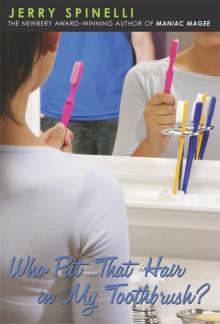 Who Put That Hair in My Toothbrush?
Who Put That Hair in My Toothbrush?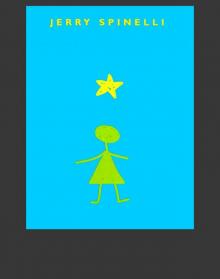 Stargirl
Stargirl Loser
Loser Jake and Lily
Jake and Lily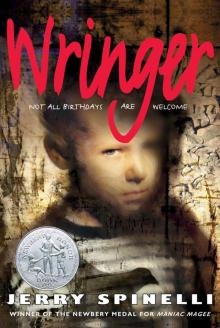 Wringer
Wringer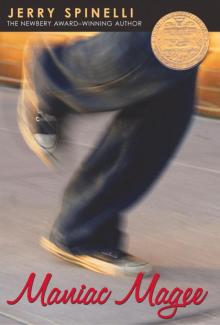 Maniac Magee
Maniac Magee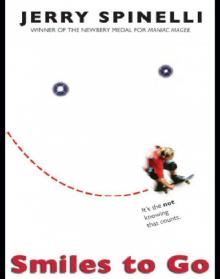 Smiles to Go
Smiles to Go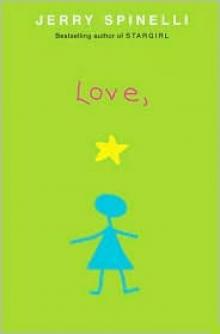 Love, Stargirl
Love, Stargirl Hokey Pokey
Hokey Pokey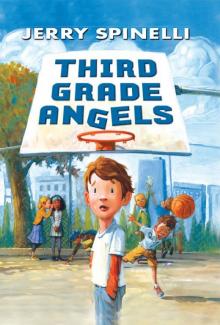 Third Grade Angels
Third Grade Angels Tooter Pepperday: A Tooter Tale
Tooter Pepperday: A Tooter Tale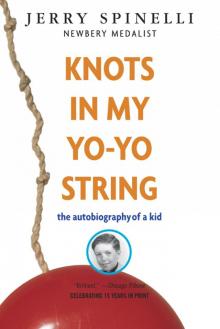 Knots in My Yo-Yo String Knots in My Yo-Yo String
Knots in My Yo-Yo String Knots in My Yo-Yo String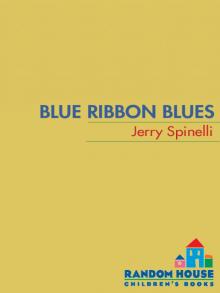 Blue Ribbon Blues: A Tooter Tale
Blue Ribbon Blues: A Tooter Tale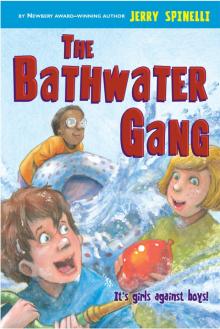 The Bathwater Gang
The Bathwater Gang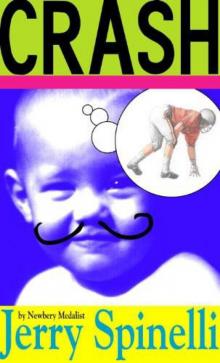 Crash
Crash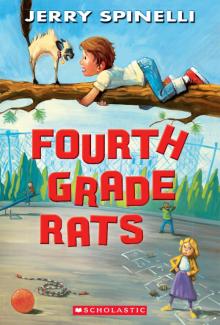 Fourth Grade Rats
Fourth Grade Rats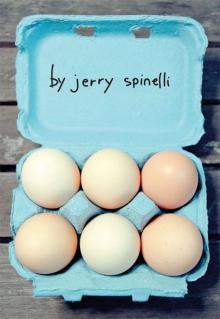 Eggs
Eggs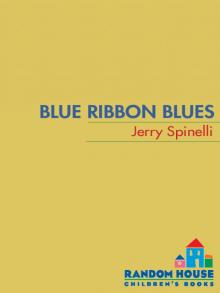 Blue Ribbon Blues
Blue Ribbon Blues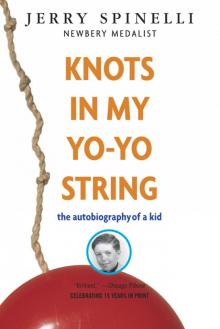 Knots in My Yo-Yo String
Knots in My Yo-Yo String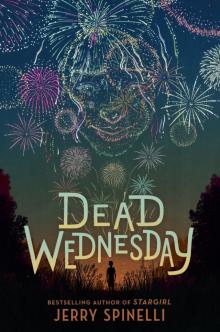 Dead Wednesday
Dead Wednesday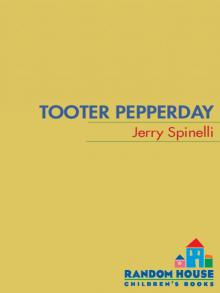 Tooter Pepperday
Tooter Pepperday